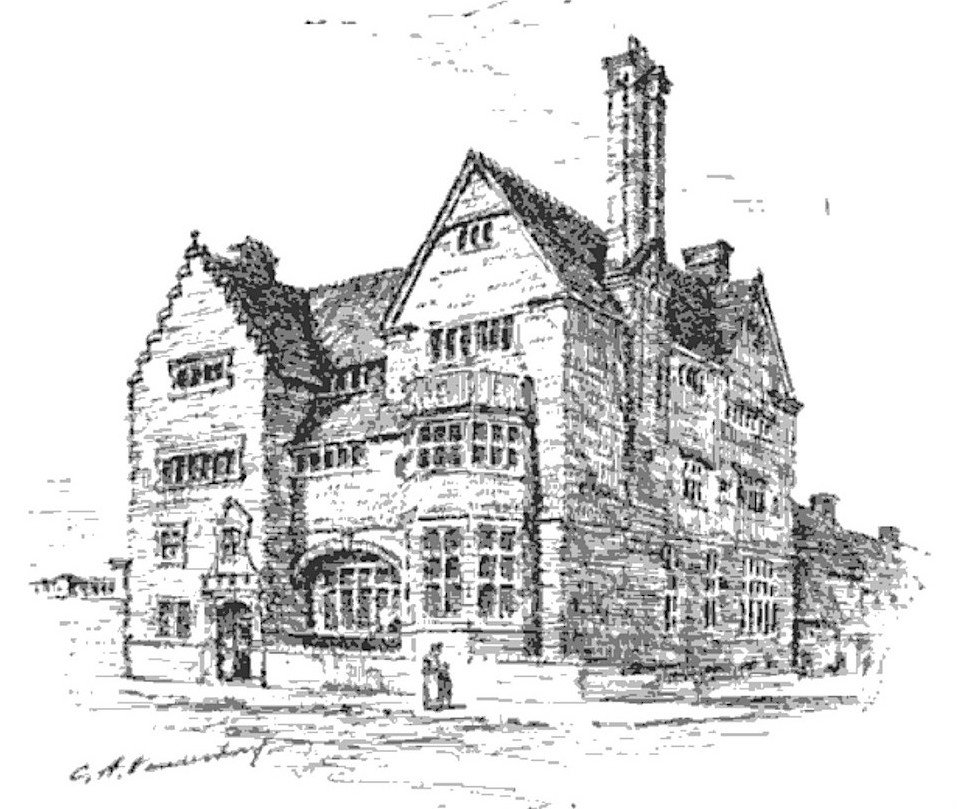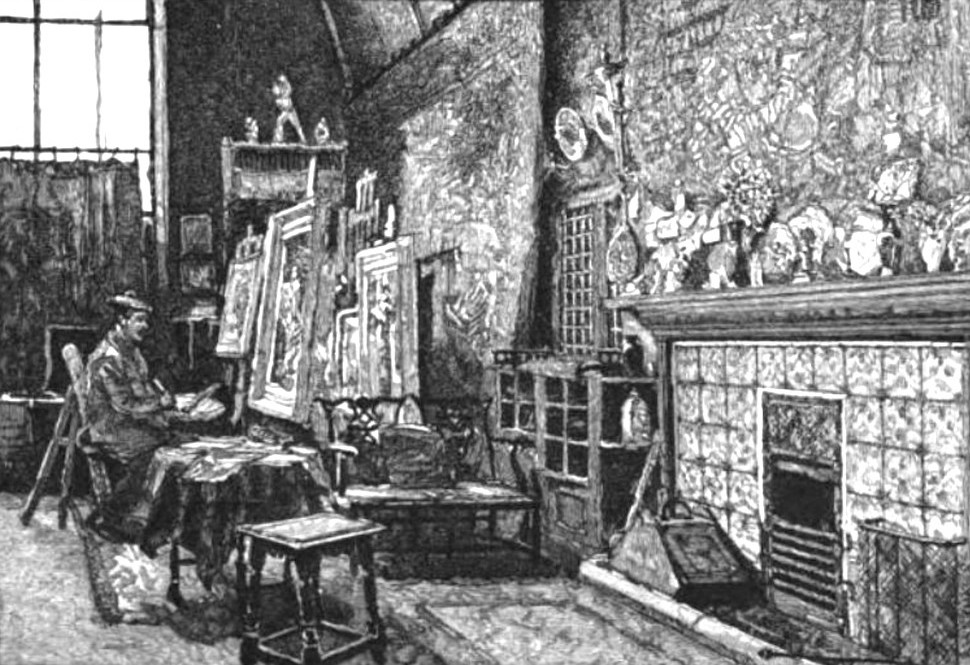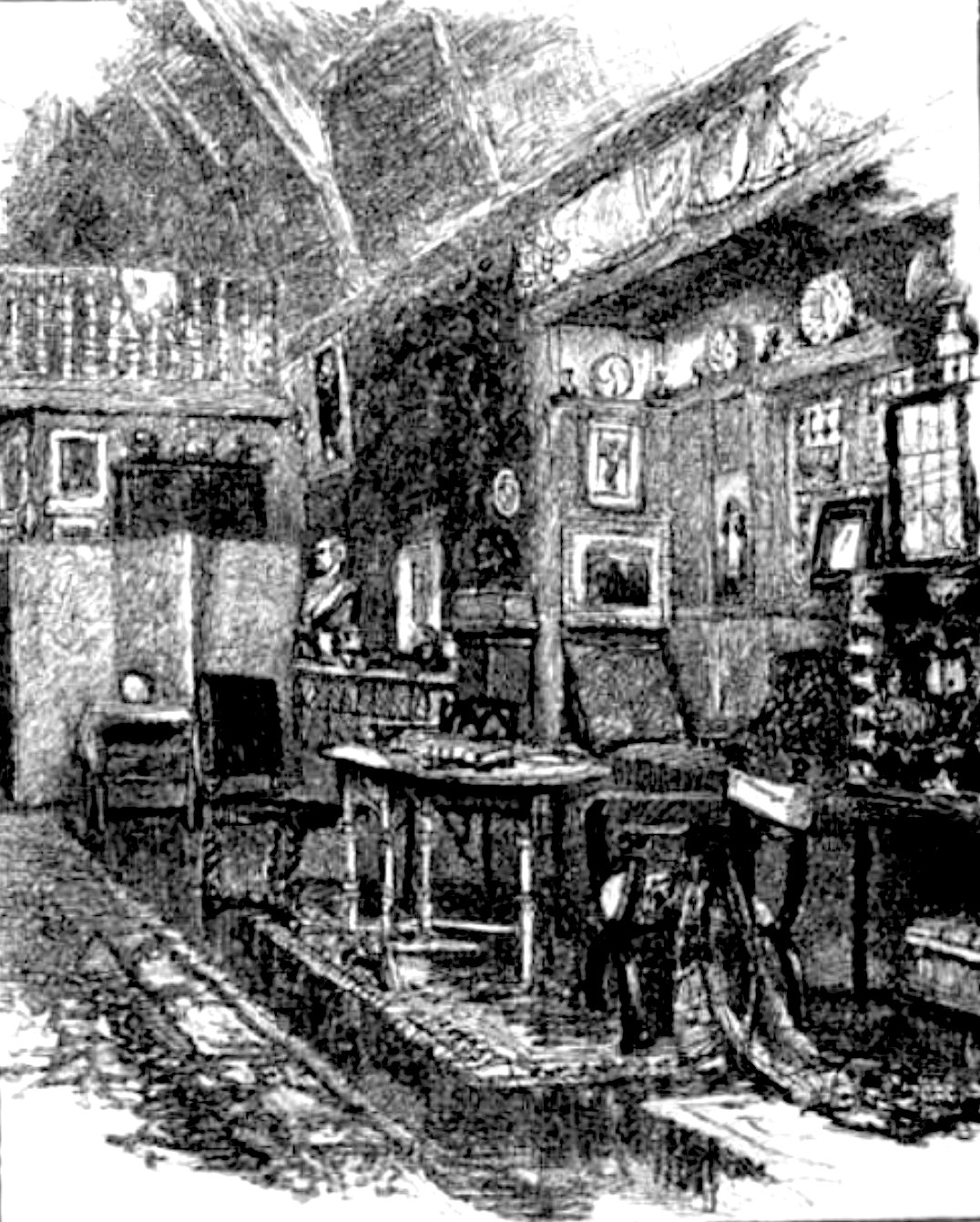The following is an extract from Cosmo Monkhouse's article, "Some English Artists and Their Studios," in The Century Illustrated Monthly Magazine of August 1882. It has been transcribed and formatted for this website, with its original illustrations, by Jacqueline Banerjee.

George H. Boughton's house, by American illustrator Charles A. Vanderhoof (1853-1918), p. 558.

ot far off [from the home of Valentine Prinsep], on the higher land called Campden Hill, is the beautiful new house of G. H. Boughton, A. R. A., an artist who found his line early and has kept to it. This line is the expression of a sentiment very characteristic of the age in which he lives. It may be called "idyllic," as that term is now used, and its source of pleasure is a sympathy with the out-door lives of ordinary persons, in states of society different from our own. This feeling, acting in the field of reality, gives interest to pictures of the fishwomen of Holland watching on the misty sands for the return of the boats, or peasants of France chatting over their midday meal. Acting on the imagination it conjures up seenes of the “good old times.” Heavier wagons lumber more slowly along rougher lanes, the spinning-wheel sings at the door, the houses are more picturesque,the costumes strange, but human nature and “the country” are unchanged, In Boughton’s work figures are no more subordinate to the landscape than landscape to figures; both are of equal importance, and the artist must be equally proficient in both.
Conventional systems of art-teaching are of little use to a man who wishes to excel in "idyllic" genre, and Boughton cut short his studies at the Royal Academy in London, and did not enter the atelier of any "professor" in Paris. Fruitful words of kindly help by Edouard Frère and other artists and unceasing study of nature have made him what he is — one of the most original and accomplished of modern English artists. A whole summer devoted to nothing but studies of sea has enabled him to make his waves break upon the shore as naturally as Mesdag* can; [561/62] and another occupied exclusively in sketching the forms of trees has made his woodland scenes no less remarkable for correctness in drawing than for a masterly generalization, which, if suggestive of the French school, is yet distinctly his own. Great facility for rapid sketching enables him, as his innumerable sketch-books bear witness, to seize in a moment any chance attitude which is expressive or beautiful, so that his figures, though generally quiet in gesture, are always alive.


Two more illustrations by Vanderhoof. Left: Boughton's studio (p. 559). Right: Other side of Boughton's studio (p. 560)
Sometimes, as in an unfinished picture now on his easel, he catches an attitude so grand and yet so natural as to be sculpturesque. Despite his changes of scene from New England to Brittany, from France to Scheveningen, from Holland to Cornwall, and corresponding changes in type of feature and costume, despite also great variety in motive-touching history in his March of Miles Standish and humor in his Wane of the Honey-moon, "people say" his pictures are too much alike. It is difficult to decide in what this likeness consists, but it is chiefly, I think, in color and in an air of quietism which spreads from his Priscilla and Hester Prynne all over his pictures. To some it may appear "mannerism"; to me it is only a personal flavor of great charm.
The beautiful house which Mr. Norman Shaw has built for him and his large, bright studio are well represented in our engravings, but the art of Boughton and of his class, such as Philip Morris, A. R. A., which seeks for its inspiration out-of-doors, is not likely to be reflected in the studio. Boughton's is full of china, bronzes, and curiosities of all kinds, but it is the unusual size of the window which floods the whole room with light which is the thing in it most characteristic of the artist as such. The rest of its rich and beautiful appointments are personal to the man of travel and culture.
* The Dutch painter Hendrik Willem Mesdag (1831–1915) was famous for his paintings of the sea.
Link to related material
Bibliography
Boughton, George Henry. Sketching Rambles in Holland. London: Macmillan, 1885. Internet Archive. Contributed by the Getty Research Institute. Web. 30 December 2021.
“Current Art —II.” The Chronicle of Art. 7 (1883-84): 392-401. Internet Archive version of a copy in the University of Toronto Library. Web. 31 December 2014.
Monkhouse, Cosmo. "Some English Artists and Their Studios." The Century Illustrated Monthly Magazine. Vol. XXIV. Century Company, 1882: 553-68. Internet Archive. Web. 30 December 2021.
Created 31 December 2021